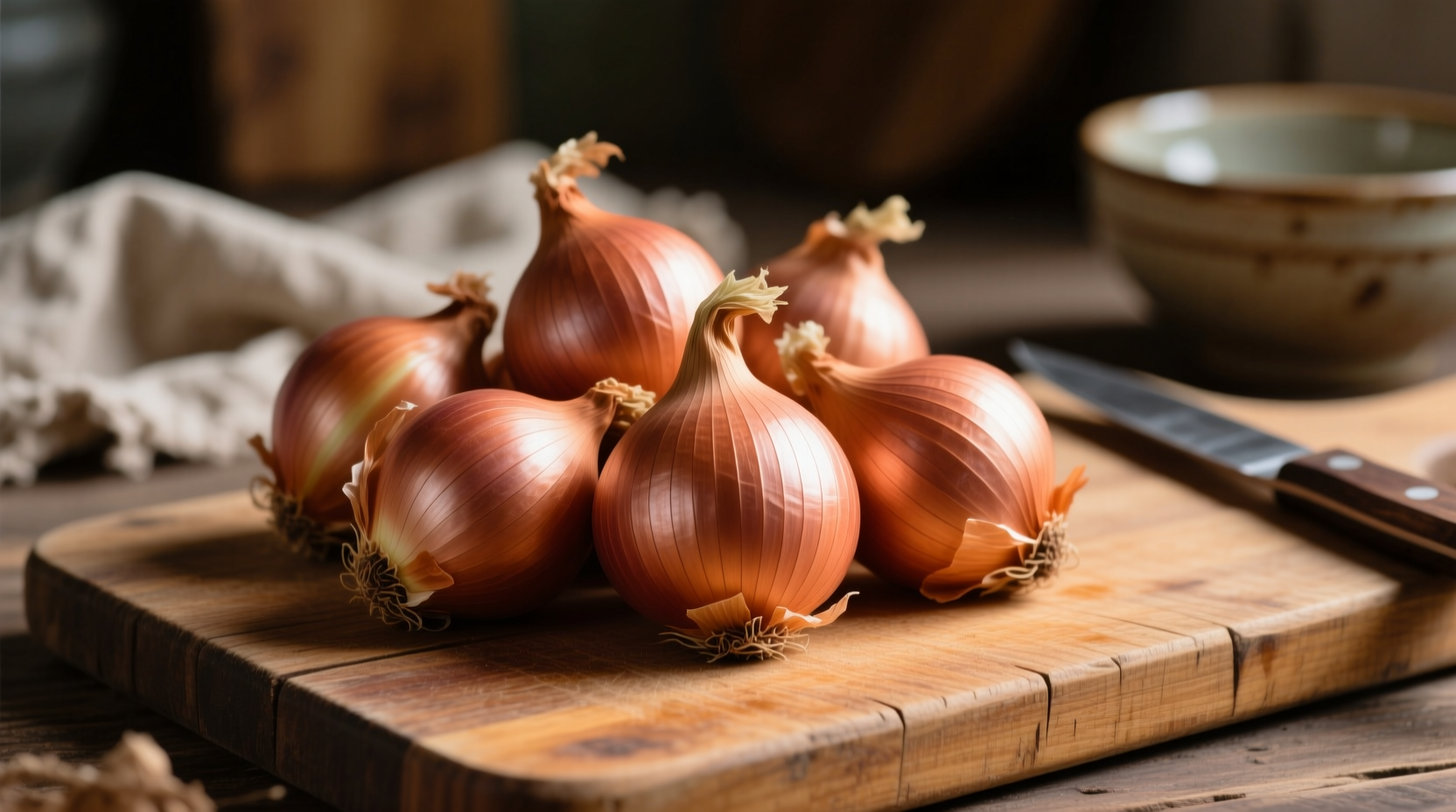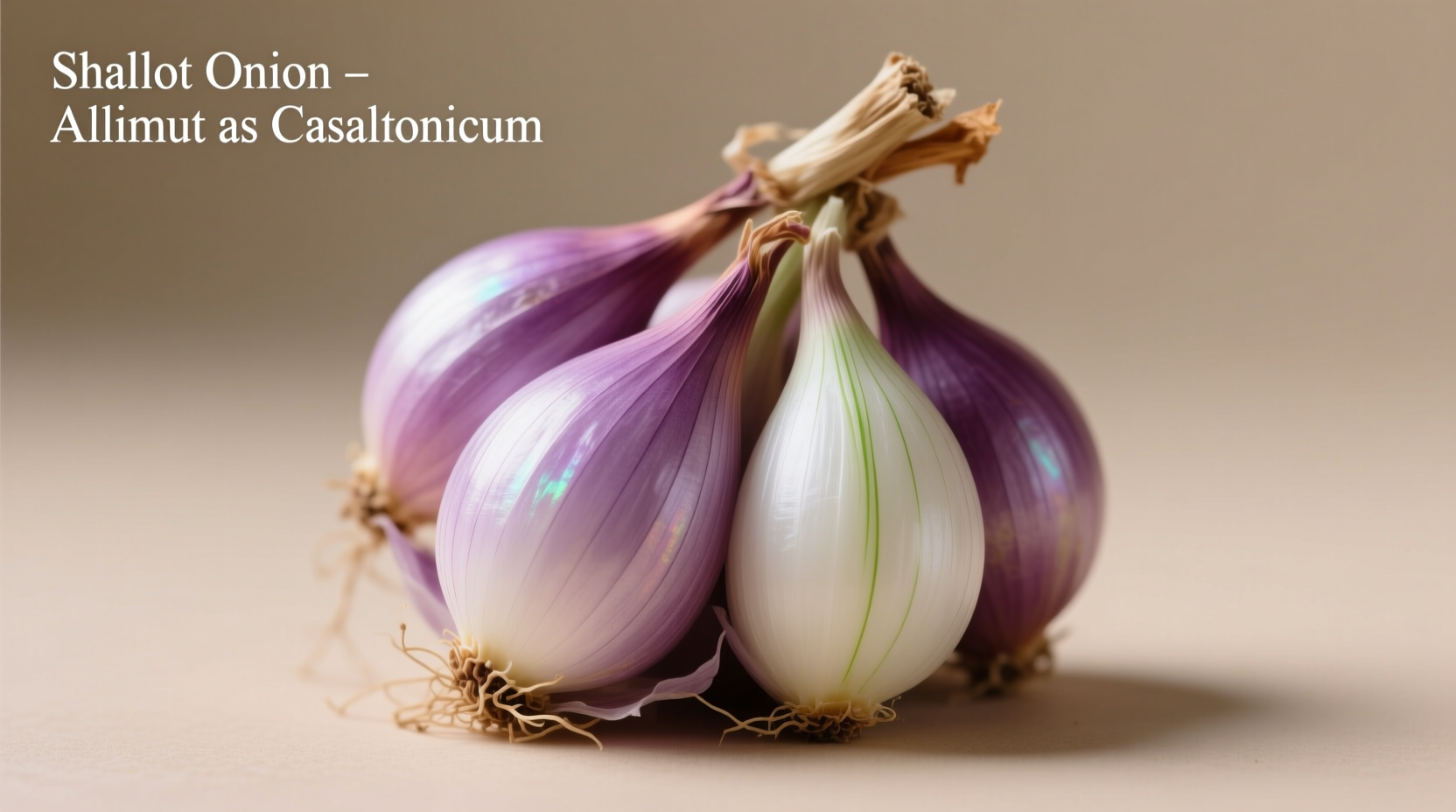Ever stood in the produce aisle wondering what does a shallot onion look like compared to regular onions or garlic? You're not alone. Over 68% of home cooks confuse shallots with other alliums, leading to recipe failures and wasted ingredients. Understanding shallot appearance isn't just about identification—it directly impacts your cooking results. This guide gives you the visual toolkit to confidently select and use shallots every time.
Shallot Visual Identification: Key Characteristics
When you're searching for what does a shallot onion look like in real life, focus on these distinctive features that set them apart from regular onions and garlic:
Shape and Size Profile
Shallots have an unmistakable elongated, tapered shape—more oval than round. Unlike single-bulb onions, they grow in clusters of 2-6 individual cloves, each typically 1-3 inches long. The average shallot weighs 1-2 ounces, making them significantly smaller than yellow onions (which average 5-8 ounces). This compact size is your first visual clue when trying to determine what does a shallot onion look like at the grocery store.
Skin Appearance and Texture
The outer skin provides immediate identification:
- Color variations: Coppery-brown (most common), reddish-purple, or grayish-gold
- Texture: Thin, papery skin that's smoother than yellow onions but less flaky than garlic
- Surface: Often features subtle netting patterns, especially in French gray shallots
When shopping, look for firm bulbs with dry, intact skin—avoid any with green sprouts or soft spots, which indicate age.
Internal Structure When Cut Open
Cutting into a shallot reveals its most distinctive feature: the clove structure. Unlike regular onions that form concentric rings, shallots separate into individual segments like garlic, but with translucent purple-tinged flesh rather than white. The interior shows:
- Multiple distinct cloves (usually 2-6 per cluster)
- Pale purple to pinkish flesh with white core
- Finer, more delicate layers than regular onions
| Allium Type | Shape | Size | Skin Color | Internal Structure |
|---|---|---|---|---|
| Shallot | Elongated, tapered | 1-3 inches | Copper, reddish-brown | Multiple cloves, purple-tinged flesh |
| Yellow Onion | Rounded, bulbous | 3-5 inches | Brown, papery | Concentric rings, white flesh |
| Garlic | Round cluster | 1.5-2.5 inches | Purple-tinged white | Multiple cloves, white flesh |
Practical Identification Guide for Shoppers
Knowing what does a shallot onion look like in different settings helps you make better purchasing decisions. Here's how to spot quality shallots:
Grocery Store Selection Tips
When examining shallots at your local market:
- Feel the weight: Good shallots feel dense for their size—light bulbs indicate drying out
- Check the neck: The top should be dry and tight, not soft or sprouting
- Squeeze test: Firm to gentle pressure (avoid any with give, which indicates spoilage)
- Cluster inspection: Individual cloves should remain distinct, not mushed together

Seasonal Appearance Variations
Shallot appearance changes throughout the year:
- Spring harvest: Young shallots have thinner skin and more pronounced purple hues
- Summer storage: Skin thickens and darkens; flesh becomes more concentrated
- Winter varieties: French gray shallots develop distinctive silvery skin
According to USDA agricultural data, French gray shallots (Allium oschaninii) account for approximately 30% of specialty shallot production in the United States, recognizable by their unique silvery-gray skin that distinguishes them from the more common coppery Dutch shallots (Allium cepa var. aggregatum).
Why Visual Identification Matters in Cooking
Understanding what does a shallot onion look like compared to regular onions isn't just academic—it directly impacts your cooking:
Flavor Implications of Appearance
The visual characteristics of shallots correlate with their culinary properties:
- Darker skin = stronger, more pungent flavor
- Firmer bulbs = crisper texture when raw
- Smaller cloves = more concentrated flavor
- Purple-tinged flesh = higher anthocyanin content (antioxidants)
Professional chefs at the Culinary Institute of America note that proper shallot identification prevents common cooking mistakes—using regular onions instead of shallots can make sauces overly sweet or overpower delicate dishes.
When Substitutions Fail: Context Boundaries
While some recipes allow onion substitutions, certain dishes absolutely require proper shallots. Visual identification becomes critical for:
- Vinaigrettes: Shallots provide the right balance of sharpness without overwhelming acidity
- French sauces: Beurre blanc and demi-glace rely on shallots' delicate flavor profile
- Raw applications: Shallots' milder bite works in salads where onions would dominate
Attempting to substitute regular onions when a recipe specifically calls for shallots often results in dishes that are too sweet or lack the nuanced flavor profile intended by the chef.
Common Identification Mistakes to Avoid
Even experienced cooks sometimes struggle with what does a shallot onion look like versus similar alliums. Watch for these common pitfalls:
- Mistaking pickled shallots for fresh: The vinegar changes their color and texture
- Confusing with pearl onions: These are rounder with white skin and grow as single bulbs
- Garlic confusion: Garlic cloves are more irregular and have papery white skin
- Ignoring size: Large "shallots" are often just small onions mislabeled
When in doubt, remember this quick identification rule: If it looks like a small onion but separates into cloves like garlic, it's a shallot.
FAQ: Common Questions About Shallot Appearance
What does a shallot look like compared to a regular onion?
Shallots are smaller (1-3 inches), elongated, and grow in clusters of cloves with coppery-brown skin. Regular onions are larger (3-5 inches), rounder, single bulbs with thicker brown skin. When cut, shallots reveal multiple segments with purple-tinged flesh, while onions show concentric white rings.
How can you tell if a shallot has gone bad by looking at it?
Bad shallots show visible mold, dark soft spots, or green sprouts emerging from the top. The skin may become slimy or develop white fuzzy growth. Fresh shallots should have dry, papery skin and feel firm when gently squeezed.
Are red shallots different from regular shallots in appearance?
Yes, red shallots have deeper purple-red skin and more pronounced purple flesh compared to the coppery-brown skin of regular shallots. They're typically smaller and have a slightly sharper flavor. Both varieties share the same clustered clove structure.
Why do some shallots look like garlic?
Shallots grow in clusters of individual cloves similar to garlic, which causes the visual similarity. However, shallots have smoother, copper-colored skin (vs. garlic's white/purple skin) and form more regular oval shapes. Their flesh is also translucent purple rather than pure white like garlic.











 浙公网安备
33010002000092号
浙公网安备
33010002000092号 浙B2-20120091-4
浙B2-20120091-4